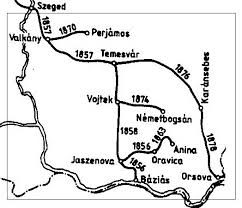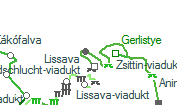The CFR Calatori 69 0003-4 seen between Ciudanovita and Garliste

Railways in the Banat region and their year of opening
Source: JANCSÓ ÁRPÁD: AZ OSZTRÁK-MAGYAR MONARCHIA ELSŐ VICINÁLISA
Banat used to be one of the most remote areas in the Kingdom of Hungary but were substantially under development after the rights to the mines, forests and land were sold to the Austro-Hungarian State Railways, which, contrary to its name, was a private company, and with its capital it could help out the government that has ran out of money. In 1856, just 12 years after the first steam railway in Hungary was built between Pest and Vác, and 8 years after the horse-drawn railway between the Danube port of Bazias (Báziás) was connected to Oravita (Oravicabánya) and Anina (Stájerlakanina), a steam railway started its operations between the port and Oravita. The railway became the first railway built in present-day Romania, but unfortunately part of it is stuck in Serbia and currently there is no traffic on it. In 1858 the railway from Szeged to Temesvár was extended to Jasenova station on the Oravita-Bazias line and this way the area gained terrestrial transport connections to the rest of the Empire. The rest of the horse railway was replaced by steam trains in 1863 which became the first mountain railway built in both Hungary and Romania, earning the name Semmering of the Banat (Bánáti Semmering/Semmeringul Banatului). The railway opened for passenger traffic in 1869. The first photo shows the most prominent mountain section of the line, the huge horseshoe between Ciudanovita and Garliste in the Jittin valley. The train is seen climbing from the direction of Oravita and the next section of the route, where the train will continue after it traverses the valley over the Jittin Viaduct, can be seen in the background on the rocky wall.
Photo by Takács Bence
Copyright 2005-2024. www.benbe.hu. Railway photography gallery of Takács Bence.



